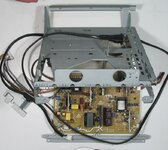Anyway it looked like feature creep was making its way in so my previous suggestion was to keep the spirit of the Classic II's logic board: connector-compatible, no PDS, no extra power, no case mods.
I'm beginning to come around to that same viewpoint, but not ready to succomb to temptation as yet.

I hope this will condense/clarify current considerations:
Apple put the the Classic in a tightly fitted straightjacket with the mezzanine level logic board mount strategy. Addressing that issue by dropping the board to ground level requires an additional ports PCB and more complicated installation process of the resulting kluge. Not good.
PDS (and probably VRAM?) on the memory subsystem riser is looking like it may need to be dialed back for KISS principle adherence. What started out as a way to condense the logic board footprint of built in RAM, DIP ROM and VRAM(?) slots would require the equivalent of widening the LCIII's ROM SIMM to that of a 72pin SIMM.
ROM and main memory can easily co-exist on a slightly modified version of the (active component/buffered) 72pin SIMM expander I have on hand as a reference design.
But VRAM is another question entirely, gut tells me that's a brick wall? Bringing PDS control lines (and VRAM lines?) up that narrow alleyway can't be done. So unless I come up with a workable interface, anything more complex than ROM slot/SIMM expansion is a no go. PCIe x16 slot connector's looking like a great prospect for getting everything on there without going Rube Goldberg on the project, but suitability needs to be verified.
No case modification is already in the specification.
There's no way around the requirement for additional power of any Classic board replacement worth doing that I can imagine.
I've already solved that power problem I think? Apple's ridiculous mezzanine level logic board makes makes that a slam dunk. The cubic underneath the Logic board seems ready made for adapting the PSU board from just about any LCD Display or the likes of a DVD player headed to recycling due to panel or mechanical failure.
Sourcing such a generic PSU board currently available may not be recycling correct, but would be KISS compliant. PSU board needs to be less than 170 x 120 millimeters for it to bolt up underneath the new logic board for the assembly slide into the chassis rails. I'd think anything in production will be 120/240 switchable?
There's no way to get around soldering a fused (and current limited?) AC connection cable from PSU to the A/B. Specifying such is well above my pay grade. For anyone up to building one of these boards, soldering that connection will be rudimentary by comparison. Soldering the AC cable extension will be well within the skill set of most folks interested in this lunacy and can be done and tested by a local friend for the rest of us.
Thoughts?


